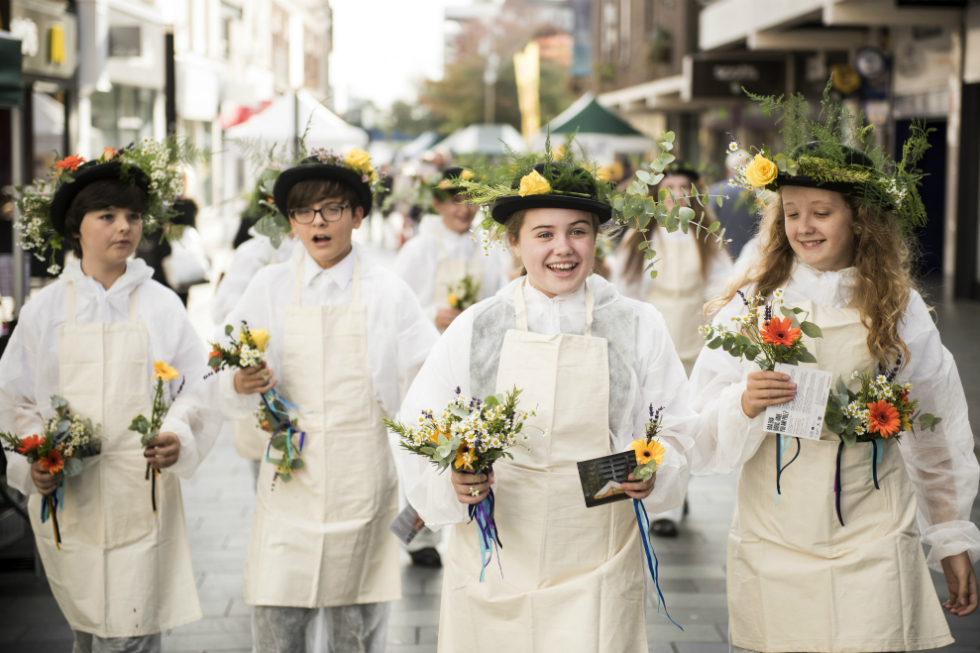
I covered artist Mark Storor’s project Baa Baa Baric for The Double Negative. Read the original article here.
“People congregate in shop fronts to catch a glimpse of the spectacle”: Mark Storor’s Baa Baa Baric

Jack Welsh joins bemused locals in St Helens to report on artist Mark Storor’s epic residency, Baa Baa Baric. Marking two years into his 12 year project for Heart of Glass, Welsh finds flowered police horses and children amongst those helping Storor to question the town’s negative stats…
Life is getting underway in St Helens town centre on a bright, autumnal September morning. The shops near Church Square – the town’s central shopping area – have just opened their doors, and early risers are milling around market stalls. But something is happening: an army of children, all dressed in white uniform, are flooding the town offering free posies to bemused locals. Many asked: “Why?”
This unassuming gesture marked the beginning of “a quiet revolution”, a daylong series of actions as part of artist Mark Storor’s 12-year artist residency Baa Baa Baric: Have You Any Pull?; made in collaboration with the people of St Helens and art organisation Heart of Glass. Two years into this epic residency, Storor has been leading workshops with various people from St Helens, including older men, young carers, the police, and students and staff at Rainford High Technology College.
Working at the cusp of live art and theatre, Storor has built a reputation for developing long-term projects in close collaboration with often vulnerable and marginalised communities. By focusing on difficult subjects – like the children ill with renal disease in his 2010 play For The Best, staged in Liverpool – Storor sees art as a vehicle to explore the experience of humanity. The resulting work is often both viscerally and aesthetically challenging.
Baa Baa Baric aims to offer a creative riposte to the negative statistics and labels attached to St Helens. Walking through the town, a series of eye-catching and fantastical portraits adorn an empty shop. Here we are introduced to several mythical figures, including The Gardener: a grey-skinned man emerging from soil, his mouth filled with lush green apples. Shot by photographer Stephen King in St Helens, these vivid portraits are entitled The Council of Wisdom, and set out to transform local, older men into theatrical God-like figures that demand we acknowledge their social value and rich life-experience. All those involved will fall into the range of St Helens’ below average life expectancy during the project, providing what Storor calls a voice “beyond the grave”.
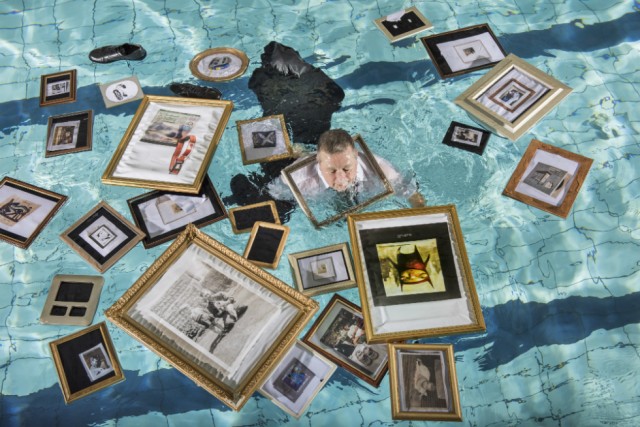
Earlier in the morning, I bump into Heart of Glass Director Patrick Fox outside Café Nero. We head over to Wesley Methodist Church, where preparations for the day are underway. Storor arrives moments later. “It’s happening; we’re in it now. This is just one moment”, he acknowledges. Storor is charismatic and warm, especially when discussing the part that children from Rainford High Technology College have had to play in this enormous project. Moments later, they arrive: the church hall blazing into life as two coach loads of Rainford pupils and staff pour in. At this point, I’m extremely thankful to have guzzled a large coffee en route.
The excitable chatter abates as Storor asks the 50 pupils – all between school years 7 and 10 – to join him sitting cross-legged in a circle. It’s no surprise to learn that Storor is a former teacher; he doesn’t talk down to the students, but converses clearly with respect and reassurance. “This is a live art event happening for the first time”, he warns. “People are unpredictable. Remember: nothing you do is wrong; it’s up to you how you engage with people. This is a one-off piece of magic.”
Storor has christened the pupils The Army of Beauty. To complete their transformation, the pupils swap one uniform for another: a white boiler suit, apron and black bowler hat adorned with flowers. They are then split into groups, led by Rainford College staff and a team from Heart of Glass, and hit the streets. Amusingly, they resemble a horde of mini-Morris dancers. I do too, as I proudly put on one of the flowered bowler hats.
Over the next hour, I observe The Army hand out 2,500 posies of flowers – a symbolic mix of rosemary, gypsophilla, gerbera and lavender is cut and handed to each pupil by Storor’s mum – across the town. While some people refuse, weary of being buttered up for a follow-up sale, many are delighted by the gesture. “I never get given anything!” gushes one delighted lady. There are many positive comments and smiles that persist after the interaction – including from the children, many of whom are understandably nervous.
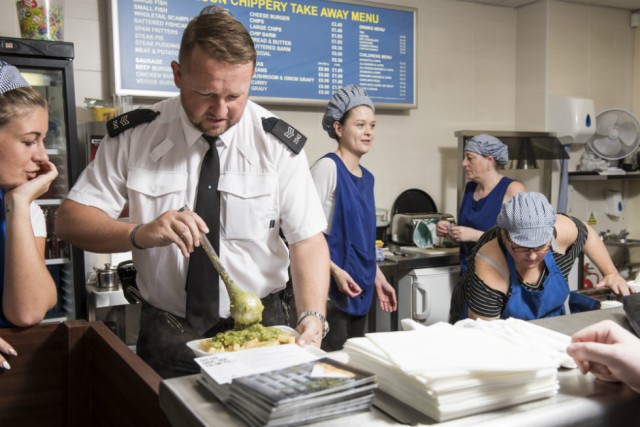
I hadn’t expected that this simple gesture would provoke so much consideration about contemporary public space; namely, how we interact with each other, and the differences between generations that co-exist everyday, often silently, in public. While flowers are an age-old motif infused with meaning and evocative of a certain feeling or emotion, the majority of people were just bloody delighted to be given flowers.
At lunchtime, I walk to Nelson Chippery where Sergeants Pope and O’Callaghan from Merseyside Police are putting in a dutiful shift behind the counter. The Chippery valiantly agreed to host the event last minute after a gas leak thwarted original plans. As Sgt Pope gingerly ladles thick gravy onto a styrofoam tray of fish, chips and mushy peas, the customer jokes: “Is he YTS?” By serving free food, the police aim to highlight that 26.3% of children in St Helens are living in poverty. It’s too busy to stay long without feeling awkward.
Around the corner, and seven floors up atop of Tontine Car Park, there lies in wait possibly the best view of St Helens: a sweeping panorama that provides a clear topographical sense of the industrial forces that shaped the town. Here, we find Storor’s installation The Shed, which is a banal garden shed sitting on soil with empty Barton Pickles jars poking out, surrounded by booming audio equipment. It emits a harsh, abstract soundscape of industrial everyday sounds, including noises from the car park substation, M&S tills, and trains arriving. Inside, the shed offers refuge via the sound of a whispering child’s voice. Listening through headphones, the affecting dialogue is impactful. I close my eyes and almost felt transported to a secret fort; a sanctuary of youthful hopes and dreams. However, this ambience crashes down when, on opening your eyes, you’re back in, well, a garden shed. It’s a clumsy realisation and too literal rendering of the outer/inner world binary.
The climax of the day is a parade through town that unites the strands: The Army of Beauty, horse-mounted police officers, and the smartly-dressed gentlemen of The Council of Wisdom. After a symbolic group photograph outside Tontine, they pull together into a procession. Intrigued crowds start to gather as two members of The Army signal the start of the procession with trumpet call. The parade falls silent and begins its march to the Town Hall, led by police horses who have flowers flowing from their manes and tails. People congregate in shop fronts to catch a glimpse of the spectacle.
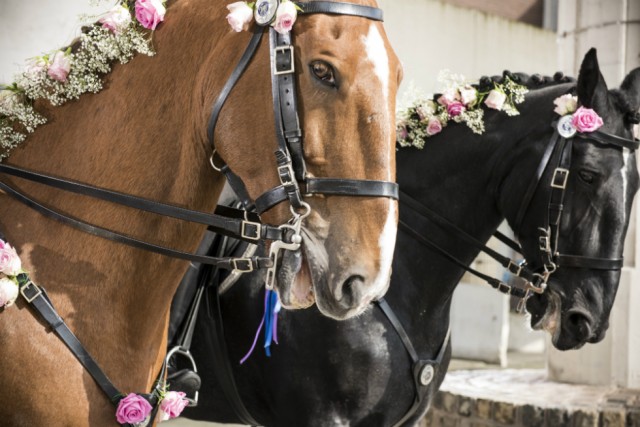
I manage to speak to members of the Council of Wisdom: Gary, John, Steven, David and Ant. All local men, they became involved in the project early on and speak positively about working with Storor, emphasizing his vivid imagination. “Older men are often marginalised and lack an outlet to express themselves”, Gary tells me, who also works for St Helens Council: “They are often the hardest to reach group and have an alarmingly high suicide rate.” He says the project gave the men confidence in sharing their experiences, and also with working with children, removing any social stigma.
As we march past the Council of Wisdom portraits, I ask Gary how he feels seeing himself as an artwork. “It was great, but feels weird seeing it up. I haven’t told any of my friends yet.” He laughs. “I’m just waiting for the messages on my golf mates’ Whatsapp group when they find out!”
On reaching the Town Hall, The Army lines up in single columns before the steps. Police horses flank them, with the Council of Wisdom at the rear. Several of The Army cadets step forward, hoisting a large banner. On it is a statement that will become the foundation for a Children’s Charter for the borough. A young boy eloquently reads out the text into a microphone:
“I am the fire speaking my mind and sticking up for other people’s rights… I am the swirls of democracy… I am the jagged angles of a blue triangle which make me imperfect and human, not like a robot.”
The banner is then folded by the children and symbolically presented to the councillors. The children are a huge credit; they’ve acted impeccably throughout the day and have embraced it with gusto. While the acceptance speech from St Helens Council is anything but inspiring, it does signal an institutional promise in the creative potential of young people.
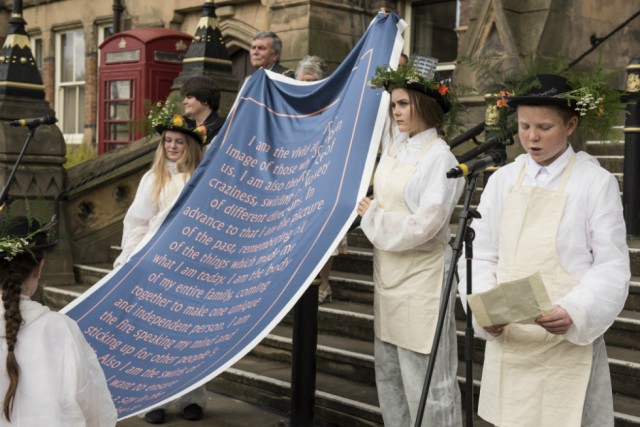
The procession is one of humanity’s oldest ceremonial rituals. Jeremy Deller’s 2009 work Procession used this vernacular as a celebration of those who occupied Manchester’s public space at that time. Storor draws on military connotations (such as uniform, formation, and police horses as agents of authority and hierarchy) to create a subversive edge, which distils his creative fairy-tale narratives with a potency; a critical point that engages with institutional forces. While the daylong event would have benefitted from a ‘less is more’ approach, ultimately, it was the first act of an evolving work over the next decade.
As creative subjects are being increasingly squeezed in the national curriculum, new ways of encouraging young people to dream, think and look at the world are very welcome. In reflection, I remember Storor’s rallying call to pupils that morning, as something that cannot be experienced in school, and is more important as a result: “St Helens isn’t going to know what happened to it. Afterwards, they’ll be asking: ‘Was that a dream?’”
Jack Welsh
This article has been commissioned by Heart of Glass. Read more about their 12-year project with Mark Storor here
Jack saw Storor’s Baa Baa Baric: Have You Any Pull? in St Helens, Merseyside, on Thursday 29 September 2017
Images from top: The Army of Beauty; portrait of Mike from The Council of Wisdom, shot by (and courtesy of) photographer Stephen King in St Helens; the police horses on parade; The Army of Beauty read out the Children’s Charter outside St Helens Town Hall. All images from Mark Storor’s Baric: Have You Any Pull? 2017. Images courtesy the artist and Heart of Glass unless otherwise stated.